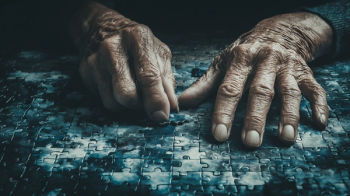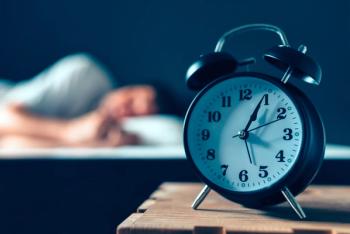
- Vol 42, Issue 8
Sleep-Related Eating Disorder: A Distressing But Treatable Complex Parasomnia
Key Takeaways
- SRED is a parasomnia involving involuntary nocturnal eating, often with limited awareness and recall, and can coexist with other parasomnias.
- Triggers include stress, medication, and medical conditions, with a higher prevalence in women and significant diagnostic delays.
Discover the complexities of sleep-related eating disorder, its symptoms, triggers, and effective treatments for better sleep health.
Sleep-related eating disorder (SRED) is a parasomnia (ie, sleep behavior disorder) characterized by recurrent episodes of involuntary eating and drinking during arousals from non-REM sleep, usually with partial or no awareness and limited or no recall.1 SRED is 1 of 2 appetitive parasomnias, along with sleep-related abnormal sexual behaviors (commonly known as sexsomnia), in which a full range of sexual behaviors can emerge during sleep.1 These 2 appetitive parasomnias can manifest in the same patient, along with up to 6 parasomnias, with or without obstructive sleep apnea (OSA), comprising the parasomnia overlap disorder.1-3 Because of space restrictions, only SRED will be discussed in this article.
Clinical Findings
The initial reported series on SRED comprised 38 patients presenting to a multidisciplinary sleep disorders center4,5 and 23 patients presenting to a sleep disorders center located in a psychiatric hospital.6 These patients had undergone extensive clinical and video-polysomnographic (vPSG) evaluations in hospital-based sleep labs with a sleep technologist in attendance all night. A subsequent clinical and vPSG study compared 15 patients with SRED, 21 patients who experience sleepwalking (SW), and 20 controls, which concluded that SRED was a specialized form of SW.7
The diagnostic criteria for SRED are listed in
Triggers for the onset of SRED include acute stress (usually major separation reactions), cessation of cigarette smoking, cessation of alcohol and substance abuse, daytime dieting, and the onset of narcolepsy, autoimmune hepatitis, encephalitis, Parkinson disease, and other conditions. However, once SRED emerges, regardless of its trigger(s) and comorbidities, SRED demonstrates a typical, relentless longitudinal course. Also, secondary food restriction during the day as a maladaptive response to overeating with SRED may then exacerbate the SRED due to inadequate total caloric intake during the day. Patients may also engage in potentially hazardous and expensive weight loss regimens. Screening for SRED prior to bariatric surgery for morbid obesity is recommended, as SRED may complicate the postoperative course of patients undergoing bariatric surgery.
SRED is distressing for the following reasons:
1. Adverse health consequences: Some patients with morbid obesity from SRED eventually need to undergo bariatric surgery. Also, overnight fasting prior to next-day surgery or blood testing can be compromised. Morning anorexia, abdominal distention, and feeling nonrestored from sleep are commonly present. Secondary depressive reactions may emerge from long-standing personal dejection and a sense of failure over the inability to control one’s eating during the night.
2. Consumption of bizarre/inedible/toxic items: Some items that have been reported include raw bacon; cat food; salt sandwiches; buttered cigarettes; fingernail polish; glue; ammonia cleaning solutions; and Coca-Cola, coffee grounds, and eggs and their shells put in a blender and then consumed.
3. Injuries: Lacerations from careless use of kitchen knives, chipped teeth from biting a frozen pizza, and internal or external burns from consuming or spilling hot foods and beverages or from handling hot items on the stove top or in the oven have been reported. Fires can occur when an individual with SRED begins to cook food and then abandons it, returning to bed.
4. Interpersonal problems with spouse/significant other: Relationships can face challenges because of the inappropriate nocturnal eating with sleep disruption, and from bringing food to the bed and leaving a mess.
The prevalence of SRED is still not well known. In a study that used a self-report questionnaire, almost 5.0% of the sample described symptoms consistent with SRED. An inpatient eating disorders group had nearly twice the prevalence (16.7%) of an outpatient eating disorders sample (8.7%), which had nearly twice the prevalence of an unselected student sample (4.6%).8 Subjects with SRED endorsed more symptoms of sleep disorders and had higher levels of depression and dissociation than those without nocturnal eating.
SRED in Psychiatric Outpatients
Two studies have addressed this pertinent topic.9,10 The first study found a 4% lifetime and 2.4% 1-year prevalence of SRED, with an 82% rate of women with SRED compared with a 68% rate for all female psychiatric outpatients.9 Patients with SRED had significantly greater depressive disorders and significantly less psychotic spectrum disorders/bipolar disorder compared with patients without SRED. Polypharmacy was more common in the SRED group compared with the non-SRED group. Thus, SRED was found to be common and underrecognized in psychiatric outpatients.
The second study assessed the frequency of SRED in psychiatric outpatients taking hypnotics.10 This cross-sectional questionnaire study found an 8.4% rate of SRED, with a significantly younger age compared with the non-SRED group. The SRED group took significantly higher bedtime diazepam-equivalent doses of hypnotics than those without SRED. Additionally, patients taking more than 2 antipsychotics were at increased risk for SRED.
Psychotropic Medication–Induced SRED
Two early case series from 2002 and 200511,12 on zolpidem-induced SRED ushered in a robust literature that culminated in a US Food and Drug Administration black box warning in 2019. The first series involved an insomnia complaint from 5 patients who developed SRED with zolpidem therapy.11 However, only 1 of these 5 patients turned out to have “psychophysiologic insomnia.” All 5 patients had restless legs syndrome (RLS), 3 had OSA, and 2 experienced SW. The SRED remitted when the zolpidem was discontinued, and the associated sleep disorders were effectively treated.
The second series gathered 19 patients from an outpatient psychiatry clinic (n = 11) and from a sleep disorders clinic (n = 8) at the same hospital over a 2-year period.12 The mean age was 47 years (range, 17-78 years), and 84% were women. Recent and/or current major depressive disorder affected 84%, and 89.5% were taking antidepressant drugs when zolpidem induced SRED. The majority of patients were taking other medications for various psychiatric and medical disorders. Two patients started kitchen fires related to zolpidem, and 2 other patients engaged in “sleep driving” related to zolpidem. No patient had a history of SRED, few patients had a history of any other parasomnia, and 1 patient had a history of daytime eating disorder. Most of these patients served as their own controls, as they had taken other hypnotic or bedtime medications before or after the time they had taken zolpidem, without developing any SRED, SW, or “sleep driving.” All patients had persistent insomnia, 42% (8/19) had more than 1 other sleep disorder but no prior SRED. Cessation of zolpidem promptly stopped the SRED. The conclusion was that women with insomnia taking 10 to 20 mg of zolpidem and taking medications for major depression and other psychiatric, sleep, or medical disorders appear to be most vulnerable to developing SRED.
A comprehensive literature search on published cases of zolpidem- associated SRED found 40 cases (65% women), with 95% having onset of SRED with a nightly dose of zolpidem greater than or equal to 10 mg.13 The onset of SRED ranged from the first dose to after 9 years of use. Nightly SRED occurred in 57.5% of patients. Discontinuation of zolpidem promptly resolved the SRED in all patients. Comorbidities included psychiatric disorders (including depression in 32%) and sleep disorders (OSA in 35%; RLS in 25%). Control of comorbid sleep disorders did not resolve the zolpidem-induced SRED.
Therapy for SRED
SRED is probably the most challenging parasomnia to manage.
An extensive review of SRED therapies has recently been published.14 Topiramate, SSRIs, and dopaminergic agents are first-line therapies. Topiramate has also been reported to induce cessation of sleep-related smoking together with SRED.18 Suvorexant, from a novel class of insomnia medications, has recently been reported to be effective in controlling SRED.19 Atherapeutic approach for managing SRED cases would be to first discontinue any triggering medication. For other SRED cases, therapy should start with topiramate or SSRI monotherapy, or dopaminergic therapy, either alone or in combination with codeine and/or clonazepam. In cases where RLS is present, treatment with dopaminergic agents (at times with combined therapy) is the preferred treatment.
We now present 2 published cases that describe middle-aged men with SRED who responded robustly to low-dose sertraline, offering an alternative therapeutic approach, particularly when conventional hypnotics or antiepileptic agents are contraindicated.14
Case 1: Treatment-Resistant SRED in a Software Engineer With Obesity
Patient profile: “Michael,” a 36-year-old male software developer, presented with nightly episodes of involuntary eating that arose during sleep, beginning 7 years ago, following smoking cessation and occupational stress. He reported no prior history of SW, other parasomnias, or RLS.
Clinical presentation: His wife witnessed 2 to 5 episodes of sleep eating per night. Michael had partial recall for 25% of the events and no memory for approximately 75% of the events. Despite locking food cabinets, Michael still managed to acquire food after falling asleep. Despite dieting and regular exercise, he gained 50 lb over time (BMI: 38.5 kg/m²), which was attributed to the sleep- related eating. Morning exhaustion and anorexia were noted, along with occasional exacerbation of SRED after jogging or working late. Prior treatments (melatonin, trazodone) improved perceived sleep quality but not SRED. Clonazepam worsened SRED symptoms and was discontinued.
Psychiatric evaluation: A comprehensive psychiatric and sleep evaluation revealed no major mood or anxiety disorder per the DSM-5. The Epworth Sleepiness Scale score was normal at 5/24. Michael had mild situational anxiety but denied depression, substance use, or RLS. There was no family history of parasomnia.
Sleep study findings: The patient underwent a vPSG, which did not detect OSA or excessive periodic limb movements (PLMs) during sleep. His sleep architecture was within normal limits, and mild snoring was observed.
Treatment and outcome: Michael was initially recommended to keep consistent bedtime and wake-up times, improve sleep hygiene, and increase his total amount of sleep, which only mildly ameliorated the SRED; therefore, pharmacologic recommendation was considered. Although topiramate was initially considered, given his mild anxiety, 25 mg of sertraline at bedtime was initiated. Remarkably, Michael reported complete cessation of sleep-related eating after the first dose, with sustained remission at 19-month follow-up while taking the same initial dose of 25 mg. Subsequent follow-up confirmed no further SRED episodes. Additionally, he also noted a marked reduction in anxiety within 24 hours of starting treatment. No adverse effects were reported.
Case 2: Episodic SRED in a Commercial Airline Pilot With a History of Childhood SW
Patient profile: “James,” a 37-year-old male commercial airline pilot, reported a 3-year history of episodic SRED, with episodes occurring every 2 to 4 months, often triggered by cumulative sleep debt from long-haul flights. He had a remote history of childhood SW, last occurring at 11 years of age.
Clinical presentation: James would leave the bed while asleep, open the refrigerator, and compulsively consume food, sometimes raw items, leading to gastric upset. In one incident, he left his hotel room and descended to the hotel kitchen in search of food. He also had incidents where he burned food on a stovetop while returning to sleep in his bed. He had partial recall of these events.
Psychiatric evaluation: The Hamilton Depression Rating Scale score was 11, indicating mild depression. His Epworth Sleepiness Scale score was 8/24. There was no substance use, and his BMI was 25.5 kg/m². No psychiatric comorbidities were diagnosed, and there was no family history of parasomnias. Medical history was unremarkable.
Polysomnography findings: James underwent a vPSG, which did not detect OSA or excessive PLMs during sleep. His sleep architecture was within normal limits.
Treatment and Federal Aviation Administration (FAA) considerations: Due to occupational safety and FAA regulations, standard medications for treating SRED, such as topiramate, were contraindicated. While on vacation, clonazepam 1 mg was tried with good effect, but clonazepam must be discontinued at least 10 days before flying an aircraft. James was initially recommended to improve sleep hygiene and minimize/avoid sleep deprivation. Additionally, given his propensity to wander outside his bedroom, he was recommended to use bedroom door alarms. Subsequently, sertraline 25 mg at bedtime was prescribed as a safer long-term option and was compliant with FAA regulations.
Outcome: James noted complete and immediate remission of SRED and associated SW utilizing sertraline 25 mg at bedtime. Four months into treatment, he reported erectile dysfunction and decreased libido, both successfully managed with sildenafil 100 mg as needed, with continued SRED suppression. These benefits remained stable at a subsequent 3-month follow-up.
Concluding Thoughts
SRED is a parasomnia that can be part of complex clinical scenarios. Psychiatrists who initiate any psychotropic therapy should ask their patients at follow-up appointments about the emergence of SRED or any other parasomnia. Additionally, intake questionnaires should cover sleep questions that include SRED and other parasomnias. Finally, patients with treatment-resistant SRED should have their serum ferritin assessed, as SRED can be an early manifestation of RLS that is often associated with iron deficiency.
Dr Schenck is a senior staff psychiatrist at Hennepin County Medical Center and the Minnesota Regional Sleep Disorders Center and a professor at the University of Minnesota Medical School in Minneapolis.
Dr Varghese is the medical director of the Minnesota Regional Sleep Disorders Center and an assistant professor at the University of Minnesota.
References
1. American Academy of Sleep Medicine. International Classification of Sleep Disorders. 3rd ed. American Academy of Sleep Medicine; 2023.
2. Cicolin A, Tribolo A, Giordano A, et al.
3. Soca R, Keenan JC, Schenck CH.
4. Schenck CH, Hurwitz TD, Bundlie SR, Mahowald MW.
5. Schenck CH, Hurwitz TD, O’Connor KA, Mahowald MW.
6. Winkelman JW.
7. Brion A, Flamand M, Oudiette D, et al.
8. Winkelman JW, Herzog DB, Fava M.
9. Lam SP, Fong SY, Ho CK, et al.
10. Takaesu Y, Ishikawa J, Komada Y, et al.
11. Morgenthaler TI, Silber MH.
12. Schenck CH, Connoy DA, Castellanos M, et al.
13. Ho T, Jimenez A, Sanchez I, et al.
14. Varghese R, Rey de Castro J, Liendo C, Schenck CH.
15. Schenck CH.
16. Winkelman JW, Wipper B, Purks J, et al.
17. Schenck CH, Mahowald MW.
18. Kazi SE, Mohammed JMM, Schenck CH.
19. Matsui K, Kimura A, Nagao K, et al.
Articles in this issue
5 months ago
The CellistNewsletter
Receive trusted psychiatric news, expert analysis, and clinical insights — subscribe today to support your practice and your patients.

















